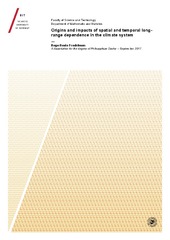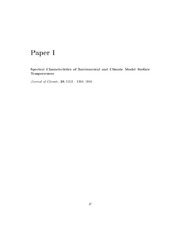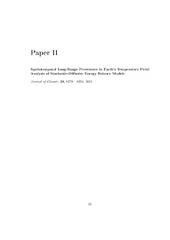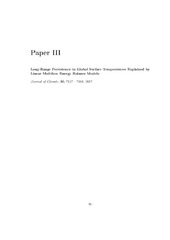| dc.contributor.advisor | Rypdal, Martin | |
| dc.contributor.author | Fredriksen, Hege-Beate | |
| dc.date.accessioned | 2017-12-12T08:55:53Z | |
| dc.date.available | 2017-12-12T08:55:53Z | |
| dc.date.issued | 2017-11-27 | |
| dc.description.abstract | The internal variability of most Earth surface temperatures has a power spectral density well described by a power law, S(f) ~ f<sup>-β</sup>, and we typically observe 0 < β < 1. This characterizes variability exhibiting long-range dependence (LRD), which has no characteristic time scale. However, there is no consensus about the physical mechanisms behind this property, and the topic of this thesis is to explore where it comes from.
In Paper I, the spectral characteristics of detrended instrumental temperature records and temperatures simulated in climate models are studied. The persistence, as measured by β, is found to be stronger for sea than for land, and increasing with the degree of spatial averaging. An interpretation of the increase with spatial averaging is that high-frequency variability is averaged out to a larger degree than low-frequency variability. Paper II presents a spatiotemporal model with this property, and more specifically, it predicts that global β is twice the value of the local β on a uniform sphere. For temperatures in observation data and climate models, there are some regional differences in the spectral characteristics, but on average they are consistent with the model.
Paper III demonstrates how LRD in global temperature can be explained by a linear multibox energy balance model (EBM). In linear models, temperatures can be described as a response function convolved with the forcing. For the multibox EBM, the response function consists of a sum of exponential responses, which with the parameters estimated, is well approximated by a power-law response. Only three boxes, implying three response times, are needed to approximate the power-law response on scales from months to centuries. When driven by white noise forcing, a power-law response gives a process exhibiting LRD, which is well approximated by the sum of Ornstein-Uhlenbeck processes obtained for the exponential responses.
This thesis also puts these concepts into the context of simple climate models in general. The findings of multiple and long response times means that we can expect continued responses to past forcing for a long time into the future – longer than predicted from simple models that do not include interaction with the deep ocean. | en_US |
| dc.description.doctoraltype | ph.d. | en_US |
| dc.description.popularabstract | This thesis focuses on statistical analyses of Earth surface temperatures, and how we can construct simple temperature models with the same properties as observations. The part of the temperature fluctuations that reflects natural variability is often well described by a property called long-range dependence. The main reason for this is the large thermal inertia of the oceans. Oceans require more heat and a longer time to heat up compared to the atmosphere, resulting in slow temperature variations with long correlations, ranging up to many decades or even centuries.
A model for global temperature is constructed by separating the ocean into a few interacting boxes forced by an energy imbalance at the surface. The output closely resembles natural temperature variations if forced by random weather variability. If forcing the same model by an increase in greenhouse gases, the temperature continues to increase due to past emissions, for a long time into the future. | en_US |
| dc.description.sponsorship | Norsk forskningsråd, KLIMAFORSK, prosjekt 229754. | en_US |
| dc.identifier.isbn | 978-82-8236-276-4 (trykt) 978-82-8236-277-1 (pdf) | |
| dc.identifier.uri | https://hdl.handle.net/10037/11847 | |
| dc.language.iso | eng | en_US |
| dc.publisher | UiT Norges arktiske universitet | en_US |
| dc.publisher | UiT The Arctic University of Norway | en_US |
| dc.rights.accessRights | openAccess | en_US |
| dc.rights.holder | Copyright 2017 The Author(s) | |
| dc.rights.uri | https://creativecommons.org/licenses/by-nc-sa/3.0 | en_US |
| dc.rights | Attribution-NonCommercial-ShareAlike 3.0 Unported (CC BY-NC-SA 3.0) | en_US |
| dc.subject | VDP::Matematikk og Naturvitenskap: 400::Matematikk: 410::Anvendt matematikk: 413 | en_US |
| dc.subject | VDP::Mathematics and natural science: 400::Mathematics: 410::Applied mathematics: 413 | en_US |
| dc.title | Origins and impacts of spatial and temporal long-range dependence in the climate system | en_US |
| dc.type | Doctoral thesis | en_US |
| dc.type | Doktorgradsavhandling | en_US |


 English
English norsk
norsk



